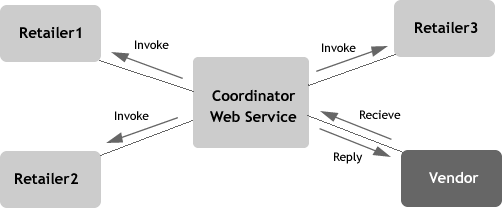Choreography and orchestration are used for combining web services and sequential execution of the web services. In orchestration, which is usually used in private business processes, a central process takes control of the involved Web services and coordinates the execution of different operations on the web services involved in the operation. Choreography does not rely on a central coordinator. Rather, each Web service involved in the choreography knows exactly when to execute its operations and with whom to interact.
Orchestration Model
Orchestration in case of multiple suppliers and one vendor (with a Coordinator in the center) is shown above. Vendor sends a message to the coordinator for getting the data from its retailers then coordinator invokes all the retailers associated with the vendor. Coordinator collects the data from all retailers and sends a reply to the vendor. Coordinator is a composite web service. This model is also called centralized model for composite web services.
Choreography Model
Choreography model used here for VMI (Vendor Managed Inventory) is for multiple retailers and multiple vendors. In this case each web service interacts with other web services directly. This model is called the decentralized or distributed composite web services model.

